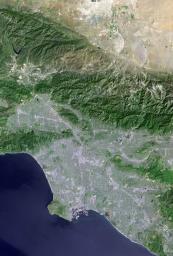Los Angeles and vicinity seen from space, as viewed by the Landsat 7 satellite from an altitude of 437 miles on May 4, 2001. North is at the top. Topographic shading has been enhanced using an elevation data set acquired by the Space Shuttle Endeavour in February 2000. Downtown Los Angeles is just south of the image center, with L.A. and Long Beach harbors to the south, Santa Monica Bay to the west, San Fernando Valley to the northwest, San Gabriel Valley to the east, and Orange County to the southeast. The San Andreas fault forms the straight diagonal mountain front bordering the Mojave Desert at the top of the image. At full resolution, features on the ground as small as 15 meters (49 feet) across can be distinguished, including street patterns and large buildings, as well as boats and their wakes on the ocean. More than ten million people live within this scene.
This image was generated by first geographically matching the Landsat scene to a Shuttle Radar Topography Mission (SRTM) elevation model. A measure of topographic slope along a southeast-northwest trend was then calculated, such that southeast facing slopes appear bright and northwest facing slopes appear dark. This slope image was then added to the enhanced Landsat scene in order to intensify the appearance of topography. Topographic shading was subtle in the original Landsat scene due to the fairly high sun angle (63 degrees above the horizon) during the satellite overflight in late morning of a mid-Spring day.
Landsat has been providing visible and infrared views of the Earth since 1972. SRTM elevation data matches the 30-meter (98-foot) resolution of most Landsat images and helps in analyzing the large and growing Landsat image archive, managed by the U.S. Geological Survey (USGS).
Elevation data used in this image was acquired by the Shuttle Radar Topography Mission (SRTM) aboard the Space Shuttle Endeavour, launched on Feb. 11, 2000. SRTM used the same radar instrument that comprised the Spaceborne Imaging Radar-C/X-Band Synthetic Aperture Radar (SIR-C/X-SAR) that flew twice on the Space Shuttle Endeavour in 1994. SRTM was designed to collect 3-D measurements of the Earth's surface. To collect the 3-D data, engineers added a 60-meter (approximately 200-foot) mast, installed additional C-band and X-band antennas, and improved tracking and navigation devices. The mission is a cooperative project between NASA, the National Imagery and Mapping Agency (NIMA) of the U.S. Department of Defense and the German and Italian space agencies. It is managed by NASA's Jet Propulsion Laboratory, Pasadena, Calif., for NASA's Earth Science Enterprise, Washington, D.C.
Size: 138.8 kilometers (86.1 miles) by 94.0 kilometers (58.3 miles)
Location: 34.1 degrees North latitude, 118.3 degrees West longitude
Orientation: North at top
Image Data: Landsat bands 3, 2+4, 1 as red, green, blue, respectively, with SRTM shaded relief, plus Landsat panchromatic band 8 added for detail.
Original Data Resolution: SRTM 1 arc-second (30 meters or 98 feet), Landsat color 30 meters (98 feet) sharpened with Landsat panchromatic band (15 meters or 49 feet).
Date Acquired: May 4, 2001 (Landsat), February 2000 (SRTM)

 Planetary Data System
Planetary Data System












